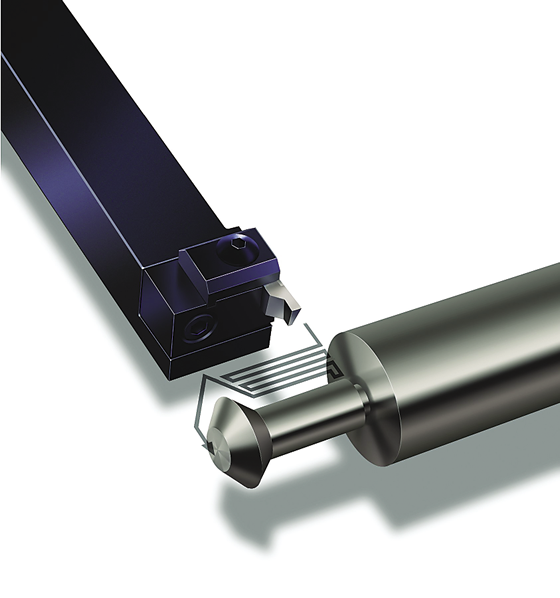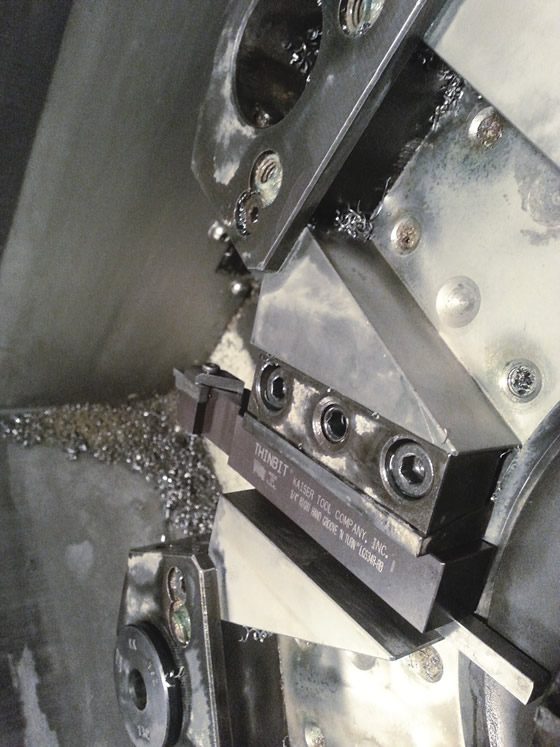END USER: Alecto Industries Inc., (708) 344-1488, www.alecto.biz.
CHALLENGE: Regain business from a former customer by winning bids on a family of shafts with multiple grooves.
SOLUTION: Versatile grooving and turning tools.
SOLUTION PROVIDER: Kaiser Tool Co. Inc., (888) THINBIT, www.thinbit.com.
A job shop typically serves a host of steady but transient customers, and while losing one always creates stress, it rarely spells catastrophe. Losing its largest customer, however, can test a shop’s ability to stay in business. Alecto Industries Inc. experienced that scenario and more during the Great Recession, noted Darren Musial, general manager for the Maywood, Ill., job shop. In addition to losing its top customer, Alecto lost several smaller ones and some of the remaining customers drastically cut their orders.
“One customer scaled back from accounting for nearly an eighth of our inventory to only ordering one or two parts per year with runs of fewer than 1,000 pieces,” Musial said.

Thinbit Groove ‘N Turn tools are ground with a clearance, enabling plunging and turning at diameter to produce the required width.
Alecto primarily serves the hydraulic, antenna, security and printing industries, producing parts from ¼" to 2" (6.35mm to 50.8mm) and larger in diameter and lengths from 0.062" (1.57mm) for washers to more than 17" (431.8mm) for shafts.
In response to the business setbacks, Alecto cut hours and costs as much as possible, according to Musial. Although it no longer received work from the customer that used to provide the most, Alecto maintained the relationship. “From time to time, we’d see quotes but not orders,” he said.
That changed when the former customer requested a quote for a family of shafts with two, four or six grooves. Groove widths ranged from 0.025" to 0.200" (0.635mm to 5.08mm), with a tolerance of ±0.0015" (0.0381mm), and diameters from 0.200" to 0.400" (5.08mm to 10.16mm), with a tolerance of ±0.001" (0.0254mm).

Alecto Industries can apply one Thinbit Groove ‘N Turn tool to produce grooves with different widths.
“When Alecto President Jim Szwaya asked me if we could run these parts, I instantly thought of Thinbit,” Musial said, referring to Thinbit grooving and turning tools from Kaiser Tool Co. Inc., Fort Wayne, Ind.
He added that one Thinbit tool can be applied to produce grooves with different widths, which reduces cycle times and provides savings that can be passed along to the customer.
He noted the shop primarily uses Thinbit Groove ‘N Turn tools, which are ground with a clearance, enabling the shop to plunge and turn at diameter to produce the required width. “Depending on the job, we also turn to rough a groove, then take a finish pass to depth, adding chamfers on the sides,” Musial said. “The versatility makes my job easier. We are always searching for ways not to pick up more tools or do any more operations or part handling than we have to.”
In addition to insert design, insert durability increases throughput by enabling high-speed grooving, according to Musial. Although Kaiser technical support recommends to “run it until you break it,” he noted going a bit slower enhances insert life while still boosting productivity by reducing the downtime required for tool changes.
Usually, though, running at breakneck speed isn’t an option. “More often than not these days, I’m running into limitations on the machines,” Musial said. “Many just cannot run at the recommended speeds.”
As a result of having the cutting tools necessary to cost-effectively perform the job, Alecto received purchase orders on some of its quotes for the shaft family, and the former customer once again became a major player at the shop. “Simply put, I’m not sure how I would be able to make these parts without Thinbit tools,” Musial said. “Outside of grinding my own HSS ‘groovers,’ no other company seems to offer the sizes we use.”
The Groove ‘N Turn line is available in 0.001" (0.025mm) increments, and on the rare occasion when a decimal size is not in stock, the wait time is only a few days, according to Musial. He said: “Perhaps what I like most about Thinbit is the simplicity. The catalog is relatively small and simple. It takes me minutes instead of hours to get the information I need.”
Related Glossary Terms
- clearance
clearance
Space provided behind a tool’s land or relief to prevent rubbing and subsequent premature deterioration of the tool. See land; relief.
- grinding
grinding
Machining operation in which material is removed from the workpiece by a powered abrasive wheel, stone, belt, paste, sheet, compound, slurry, etc. Takes various forms: surface grinding (creates flat and/or squared surfaces); cylindrical grinding (for external cylindrical and tapered shapes, fillets, undercuts, etc.); centerless grinding; chamfering; thread and form grinding; tool and cutter grinding; offhand grinding; lapping and polishing (grinding with extremely fine grits to create ultrasmooth surfaces); honing; and disc grinding.
- grooving
grooving
Machining grooves and shallow channels. Example: grooving ball-bearing raceways. Typically performed by tools that are capable of light cuts at high feed rates. Imparts high-quality finish.
- high-speed steels ( HSS)
high-speed steels ( HSS)
Available in two major types: tungsten high-speed steels (designated by letter T having tungsten as the principal alloying element) and molybdenum high-speed steels (designated by letter M having molybdenum as the principal alloying element). The type T high-speed steels containing cobalt have higher wear resistance and greater red (hot) hardness, withstanding cutting temperature up to 1,100º F (590º C). The type T steels are used to fabricate metalcutting tools (milling cutters, drills, reamers and taps), woodworking tools, various types of punches and dies, ball and roller bearings. The type M steels are used for cutting tools and various types of dies.
- tolerance
tolerance
Minimum and maximum amount a workpiece dimension is allowed to vary from a set standard and still be acceptable.
- turning
turning
Workpiece is held in a chuck, mounted on a face plate or secured between centers and rotated while a cutting tool, normally a single-point tool, is fed into it along its periphery or across its end or face. Takes the form of straight turning (cutting along the periphery of the workpiece); taper turning (creating a taper); step turning (turning different-size diameters on the same work); chamfering (beveling an edge or shoulder); facing (cutting on an end); turning threads (usually external but can be internal); roughing (high-volume metal removal); and finishing (final light cuts). Performed on lathes, turning centers, chucking machines, automatic screw machines and similar machines.







